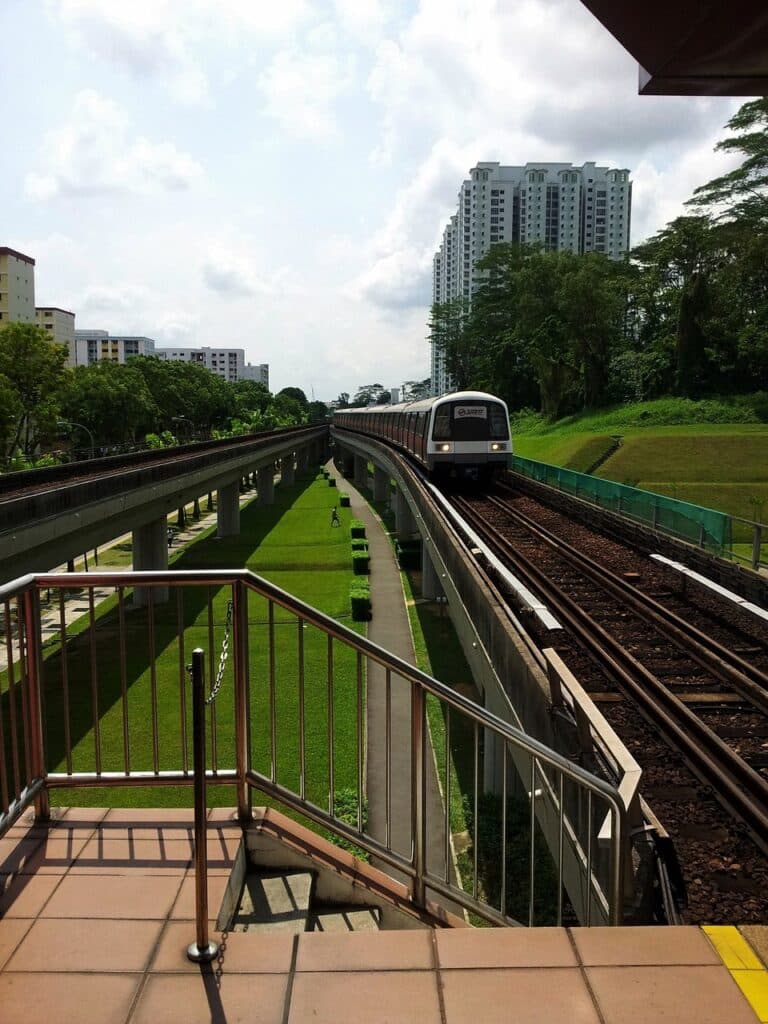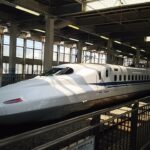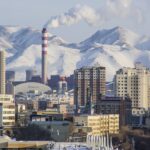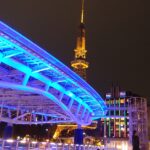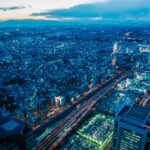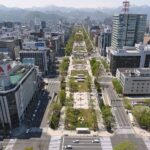Singapore has a robust and well-developed public transportation system that includes a sizable network of trains, buses, and other modes of transportation. The primary mode of public transportation in Singapore is the six-line Mass Rapid Transit (MRT) system. The North-South, East-West, Circle, and Downtown lines are responsible for serving the majority of Singapore. Additionally, there is a vast bus network with more than 4,000 buses that travel to practically every area of the island. Transport between the mainland and the offshore islands is also provided via a light rail system, ferries, and water taxis. Singapore also provides a selection of bike- and car-sharing options.
Singapore Metro (MRT): Basic Information
With six metro lines and more than 130 stops, Singapore’s metro system is a comprehensive, top-notch mode of public transportation. The Land Transport Authority runs it, and it is the quickest and most effective means to move throughout the city. There are several different fare options available for the metro system, including daily, weekly, and monthly passes as well as a tourist pass for visitors. Additionally, the system offers contactless fare payment, allowing users to pay for fares with credit cards or mobile devices. A network of bus and taxi services that can link to metro stations is also part of the metro system, making it even easier to navigate around the city.
The lines of the Singapore mRT
North-South Line (NSL) – red
The line, which is marked in red on the Singapore rail map, is 45 kilometers long and serves 27 stations, 11 of which are underground between the Bishan and Marina South Pier stations. It travels via Woodlands Station in northern Singapore from Jurong East station in Western Singapore to Marina South Pier station in the Central Area. The first departure is at 5:07 am, and the last one is at around 1 am the following day. The line runs for almost 20 hours each day, with headways of up to 1 to 2 minutes during peak hours and 5 to 8 minutes during off-peak hours. On the North-South Line, every train has a six-car layout.
East-West Line (EWL) – Green
It connects Pasir Ris station in the east with Tuas Link station in the west. It is Singapore’s second line of Mass Rapid Transit to be constructed. This distinction will go to the Cross Island line after it is fully operational in the 2040s. The line has 35 stations, 8 of which are underground (from Lavender to Tiong Bahru and Changi Airport stations). It is the longest MRT line at 57.2 kilometers (35.5 miles).
North-East Line (NEL) – PURPLE
The 20 km line, run by SBS Transit, is the MRT’s shortest. It connects 16 stations via Chinatown, Little India, Serangoon, and Hougang on its route from HarbourFront station in southern Singapore to Punggol station in the northeast. It is Singapore’s third MRT line and the first fully automated underground, driverless heavy rail line in the world.
Circle Line (CCL)
It travels in a loop that is currently unfinished from the central Singapore station of Bishan to the southern station of HarbourFront via Dhoby Ghaut. Additionally, it includes a branch from Promenade station to Marina Bay station, which will be extended to Harbourfront station starting in 2026 to provide a full loop. The subterranean route, which is orange on the train map, is 35.5 kilometers long with 30 stations. It takes about an hour to get from one end of the line to the other.
Singapore’s Downtown route (DTL) – BLUE
It travels through the Central Area from Bukit Panjang station in the northwest to Expo station in the east. The rail map’s line, which is colored blue, connects 34 underground stations. The DTL is the third underground MRT line, and the fifth overall, to open on the network. It is the second MRT line that SBS Transit runs after the North East Line.
Singapore’s Thomson-East Coast Line (TEL) – bROWN
It is completely subterranean and is shown on the rail map as brown. When finished, the line will have 32 stations and be 43 kilometers long, making it one of the longest driverless rapid transit systems in the world. Beginning in the north at Woodlands Town, it travels through Upper Thomson, the towns of Ang Mo Kio and Bishan, then turns south toward Orchard Road and Marina Bay. It then travels east along the east coast through Kallang, Marine Parade, and Bedok South before coming to a stop at Upper East Coast.
Map of Singapore Metro 2024: Free Download in PDF
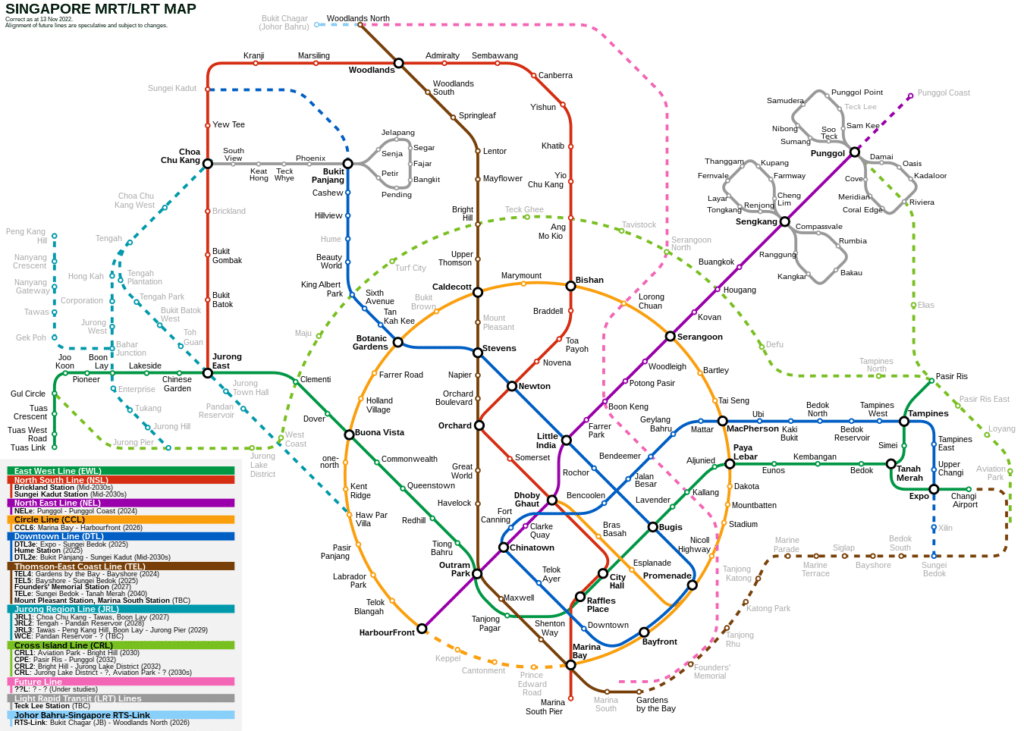
Click and download the map of Singapore’s underground system for 2023
The Singapore Metro 2024 map is currently available as a free PDF download. Anyone trying to traverse the city will find this thorough map to be a useful resource because it shows all of Singapore’s metro stations, lines, and itineraries. The Singapore Metro 2024 map makes it simple to chart out journeys, locate connections, and choose the fastest route from one place to another. This map is essential for everyone visiting Singapore, whether they are locals or tourists. Get started on your adventure right away by downloading your free copy of the Singapore Metro 2023 Map in PDF format.
Public transport tickets: best types for travelers
Both the buses and railways provide single-ride tickets. These are good for one trip on any of the public transit options. Depending on the route you choose, the cost will change, but it often ranges from $1 to $2.
There are also multi-day passes available for those seeking a more affordable option. These provide you a set number of days’ worth of access to all forms of public transit. They normally cost around $7, $12, or $18 and are offered for 1, 2, or 3 days.
A monthly pass might be something you want to think about if you want to stay in Singapore for an extended period. You can utilize all forms of public transportation with this for the entire month without having to make separate payments for each trip. The monthly pass is about $50 in price.
The best choice for travellers visiting Singapore for three days is to get a three-day pass. The cheapest option for transient tourists, this enables you to move throughout the city without having to worry about the price of each individual trip.
Summary of fares for public transport in Singapore
- Single-ride tickets are available and range in price from $1 to $2 depending on the route taken.
- Multi-day passes are priced at $7, $12, or $18 for 1, 2, or 3 days.
- A $50 monthly pass that provides access to all public transit for the entire month is also available.
Timetables & Schedules
On weekdays, the Singapore Metro system is open from 5:30 a.m. to 12 a.m., while on weekends, it is open from 5:30 a.m. to 1 a.m. During peak hours, trains run every 2 to 5 minutes, while they run every 5 to 15 minutes off-peak. During rush hours, trains operate as frequently as every 2 minutes on the North-South and East-West lines while they run as frequently as every 5 minutes on the Circle Line. Every day, from 6 am to 11 night, there are trains on the Downtown Line that run every 5 to 10 minutes. On Fridays and Saturdays, the Singapore Metro system also offers late-night service, with trains running from 12 a.m. to 2 a.m.
Other Options For Public Transportation?
In addition to the metro, Singapore offers several other public transportation choices, such as buses, taxis, and ride-sharing services. Buses have numerous routes and connections to the metro, making them a reasonably priced and dependable option to get around the city. Taxis are a more expensive but more practical choice, particularly for individuals who are pressed for time. Additionally, ride-sharing services like Grab and GoJek provide a practical and reasonably priced method of transportation. Singaporeans may travel the city in a variety of ways thanks to all of these possibilities.
public bus transportation
One of the best-linked cities in Southeast Asia is Singapore, which has a productive public bus system that is economical, dependable, and safe. SBS Transit and SMRT Buses run more than 300 bus routes throughout Singapore, providing service to the whole city-state.
Basic bus services and rapid bus services are the two categories into which the bus network in Singapore is split. While express bus services offer direct connections between particular sites, basic bus services are the most popular, serving Singapore’s major districts.
Travelers must buy an EZ-Link card, a contactless payment card that can be used on buses and trains, in order to utilize Singapore’s public bus system. Once they have their EZ-Link card, passengers can board the bus by tapping it at the card reader or by purchasing a ticket directly from the driver.
The SBS Transit Service 8, which travels from Marina Centre to Changi Airport, the SMRT Service 197, which travels from Marina Centre to Yishun, and the SBS Transit Service 10, which travels from Marina Centre to Jurong East are some of the most well-liked bus routes in Singapore.
How To Get From Singapore Changi Airport (SIN) To The City Center With Public Transport?
Taking the MRT is the most practical way to get from Singapore Changi Airport to the city center. This is Singapore’s extensive network of rapid transit systems. The Terminal 2 basement has the MRT train station. Once there, you can get on the Downtown Line or East-West Line train. You will arrive at Tanah Merah MRT Station immediately after doing this, from where you can take the East-West Line or Downtown Line to your final destination.
Numerous public bus routes travel from the airport to the city center if you’d like to take a bus. Both Terminal 1 and Terminal 2 offer the bus services. From Terminal 1, you may board the SBS Transit Bus 36 or SBS Transit Bus 39, while from Terminal 2, you can board the SBS Transit Bus 24 or SBS Transit Bus 27. You can go to the city center on any of these buses.
There is also the Changi Airport Skytrain available for those who want a more picturesque journey. There is a rail connection between Terminals 1, 2, and 3 with this service. It’s a fantastic way to navigate the airport and take in the city from above.
3 days in Singapore?
You can maximize your time and take advantage of everything Singapore has to offer if you’re visiting for the first time and just have three days to explore. Singapore offers a diverse range of cultural activities, mouthwatering dining options, and a buzzing nightlife, ensuring that your visit will be one to remember.
Start your exploration of the city on the first day by going to some of its most famous landmarks. For breathtaking views of the city skyline, head to the Singapore Flyer, the tallest observation wheel in the world. Visit the well-known Gardens by the Bay and marvel at the beautiful Supertrees. The National Museum of Singapore is another place where you may go to learn about the history and culture of the nation.
Spend the evening at the Singapore Night Safari for a distinctive experience. The park’s walking paths and wildlife enclosures are open for exploration, and after dark you may see the creatures in their natural settings.
Take a break from touring on the second day and savor some of the city’s incredible culinary choices. For a classic Singaporean breakfast and a taste of the city, visit a nearby hawker center. Try some of the city’s best street cuisine for lunch, including chicken rice, chilli crab, and laksa.
Take a cruise down the Singapore River in the evening to take in the city’s skyline lit up. Then, for some nightlife, go to the busy Clarke Quay. There are numerous eateries, bars, and clubs in the vicinity, so you may find something to your liking.
Spend some time learning about Singapore’s cultural legacy on your final day there. Experience the distinctive sights, sounds, and fragrances of Little India and Chinatown when you go there. To learn more about Buddhist customs and culture, you can also go to the Buddha Tooth Relic Temple.
What other metro systems are nearby to Singapore?
Southeast Asian nation of Singapore is renowned for having a first-rate public transportation system. Singapore does not, however, have the only comprehensive metro system in the area. The metro systems of neighboring cities, including Kuala Lumpur, Bangkok, and Jakarta are all connected to Singapore’s train system. In addition to these cities, others with advanced metro systems that are well-liked by tourists include Taipei, Hong Kong, Manila, and Ho Chi Minh City. With the help of Singapore’s rail system, it is simple to travel in comfort and style around the region and reach all these places.
Summary of our tour guide for Singapore
I’ve been able to use public transit a lot while I’ve been living in Singapore for the past three years. Singapore boasts a sizable, dependable, and user-friendly public transit system. The primary mode of public transportation in Singapore is the Mass Rapid Transit (MRT), which is a quick and effective means to move around the city. In addition to being a cost-effective choice, buses and trams are useful for traveling to locations that the MRT does not serve. In addition to using public transportation, I have also found that when I need to get somewhere quickly, taking a private taxi is convenient. Overall, Singapore offers one of the best public transportation systems in the world, which has greatly facilitated my living here.
Top 5 FAQs and answers about Singapore public transport?
How should I go about visiting Singapore?
- The response to this query is based on your individual needs and preferences. The MRT (Mass Rapid Transit) and LRT (Light Rail Transit) are typically regarded as the most effective modes of transportation in Singapore. The LRT is a smaller network of light rail transit that primarily serves the city center and surrounding districts, whereas the MRT is a large network of elevated and underground trains that cover most of the city. Buses are another well-liked transportation choice because they travel to most areas of Singapore and are typically inexpensive.
Is Singapore’s public transportation secure?
- Singapore’s public transportation system is renowned for being trustworthy and secure. All buses, railroads, and other forms of transportation undergo routine safety inspections and maintenance. You may travel with confidence in Singapore because of its extensive network of cameras and other security measures.
How much does Singaporean public transportation cost?
- The cost of taking public transportation in Singapore varies depending on the mode. As a rule, bus and MRT fares, which range from $0.50 to $2.00, are the most reasonable. The cost of an LRT ride is a little bit higher, ranging from $1 to $3.
Are there any discounts for Singapore’s public transportation?
- Yes, there are several discounts offered for Singapore’s public transportation. For instance, pensioners and students frequently qualify for reduced bus and train prices. Tourist cards are another option, which provide lower rates for several excursions.
Is there a method to monitor my transit activity in Singapore?
- I’d say there is. You may track your journey using the electronic ticketing system in Singapore’s public transportation system. You can also download apps that let you track your bus and train trips in real-time, including SG BusTracker and SG MRT Tracker.
Useful links

